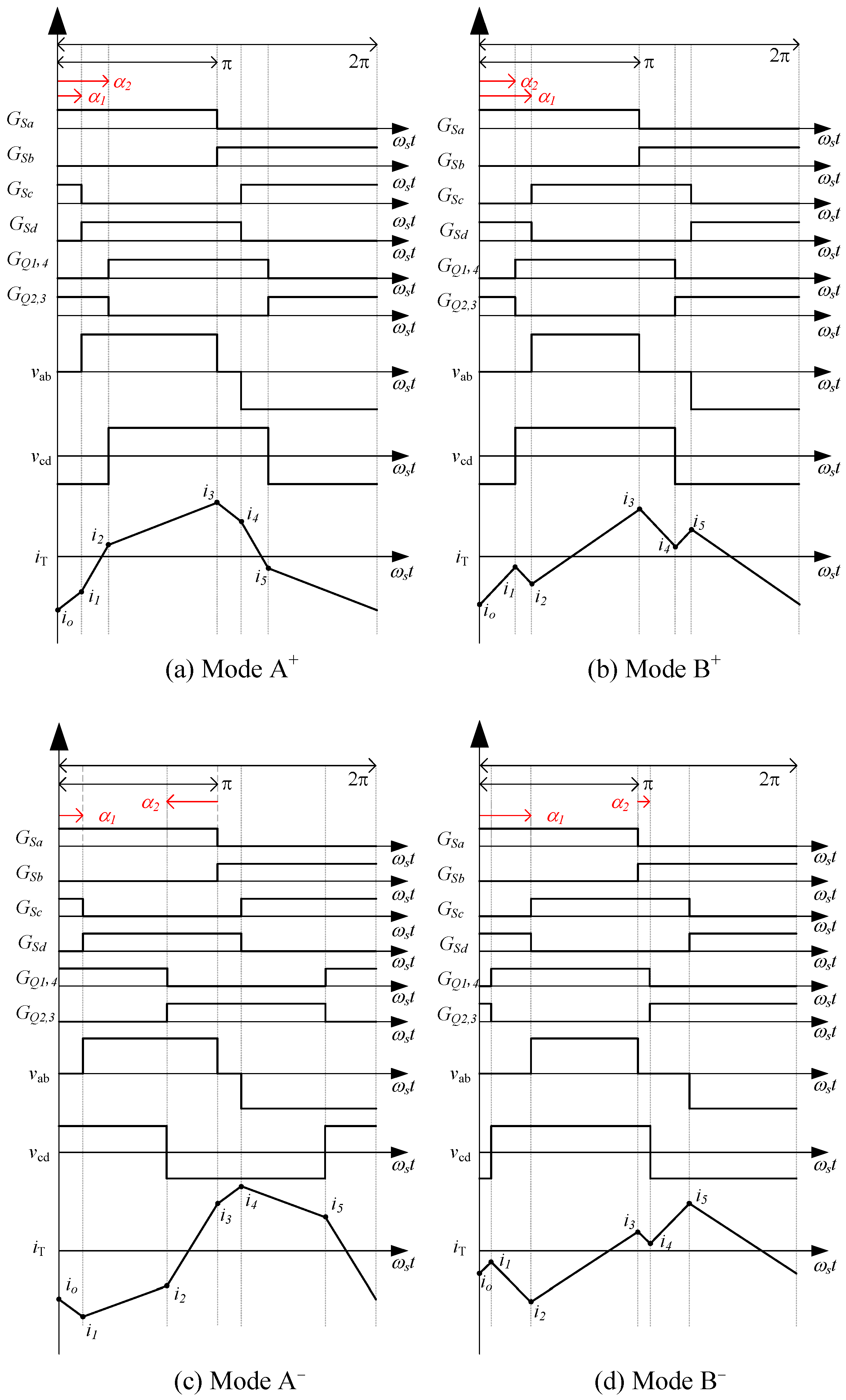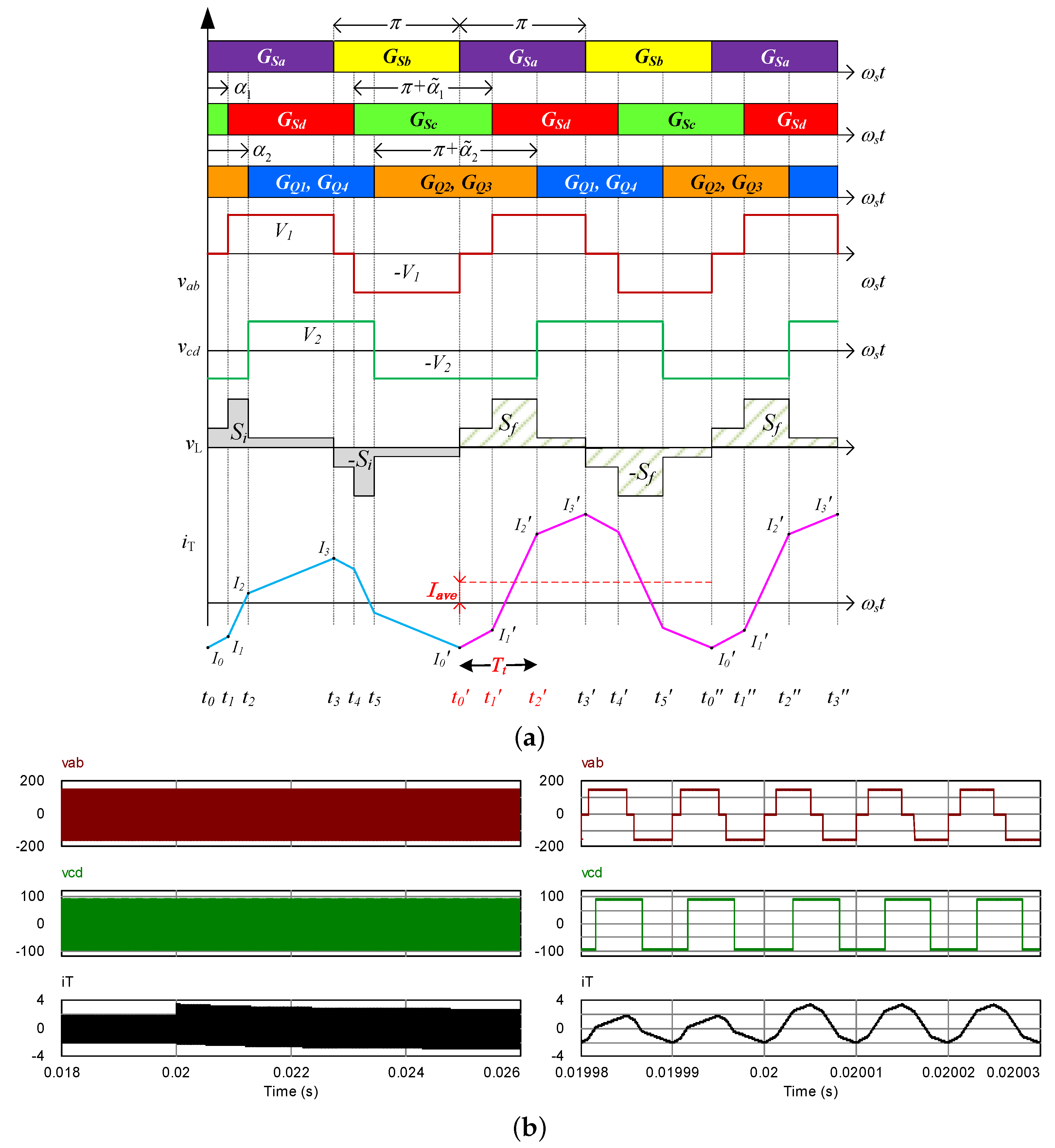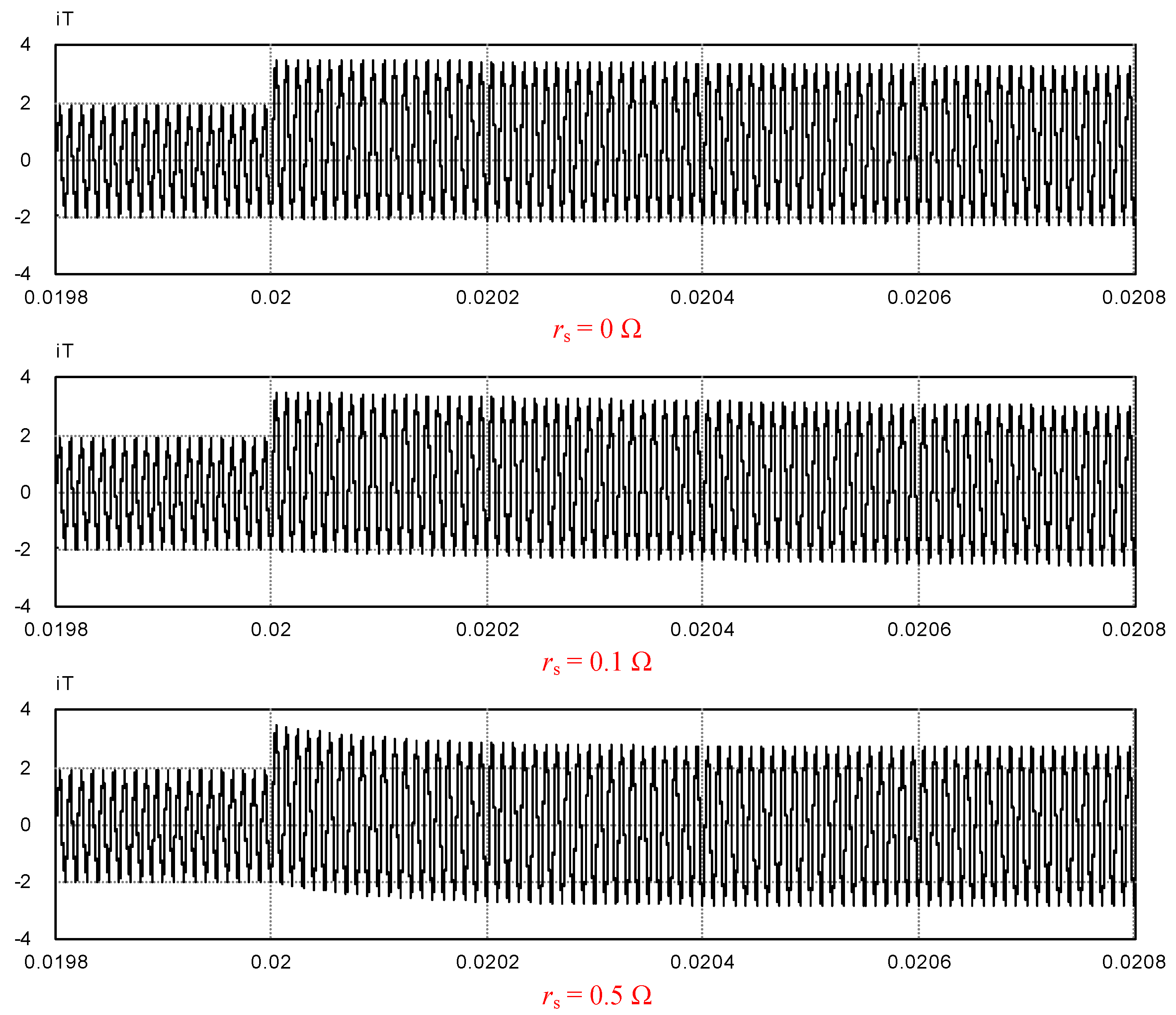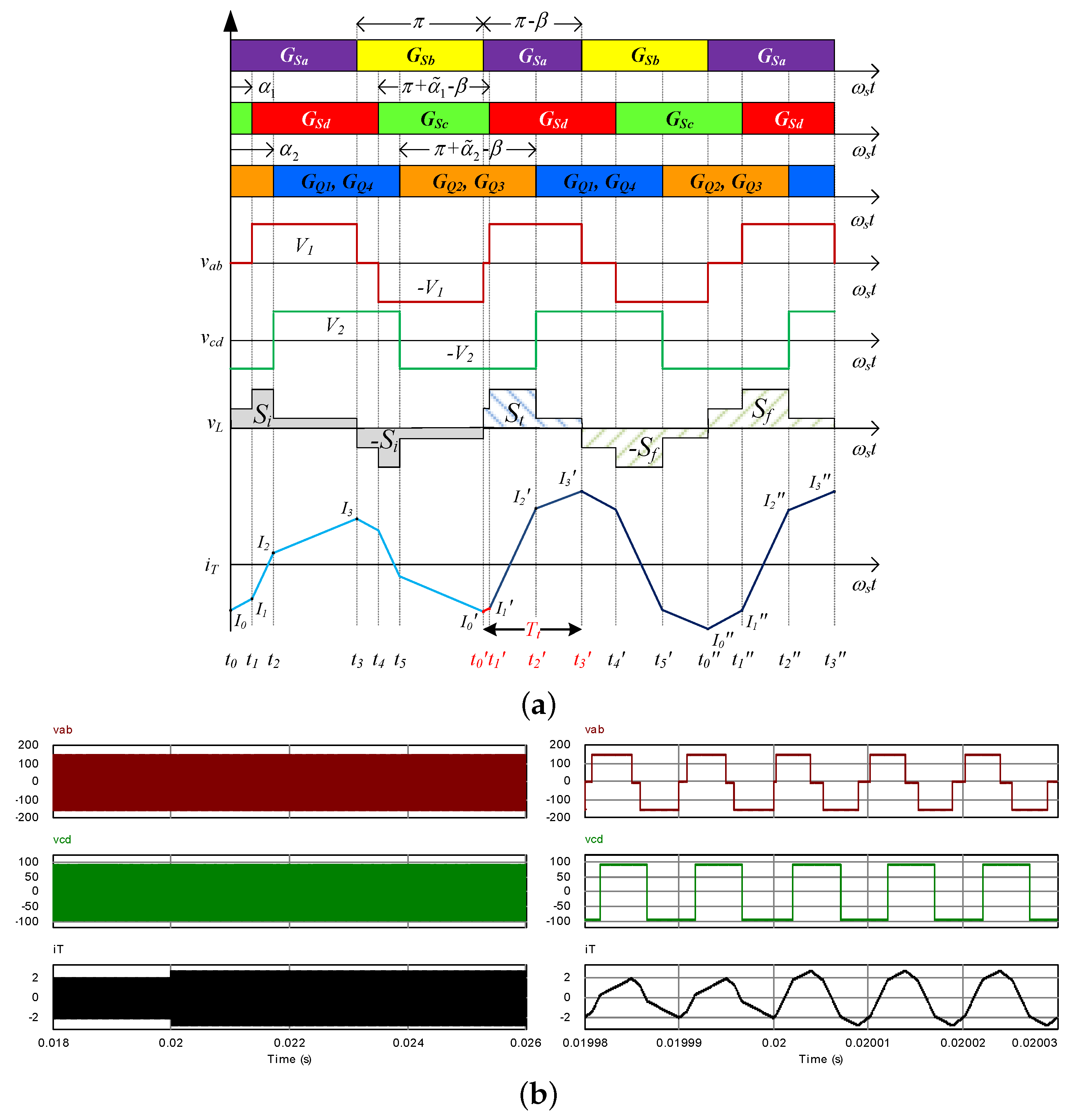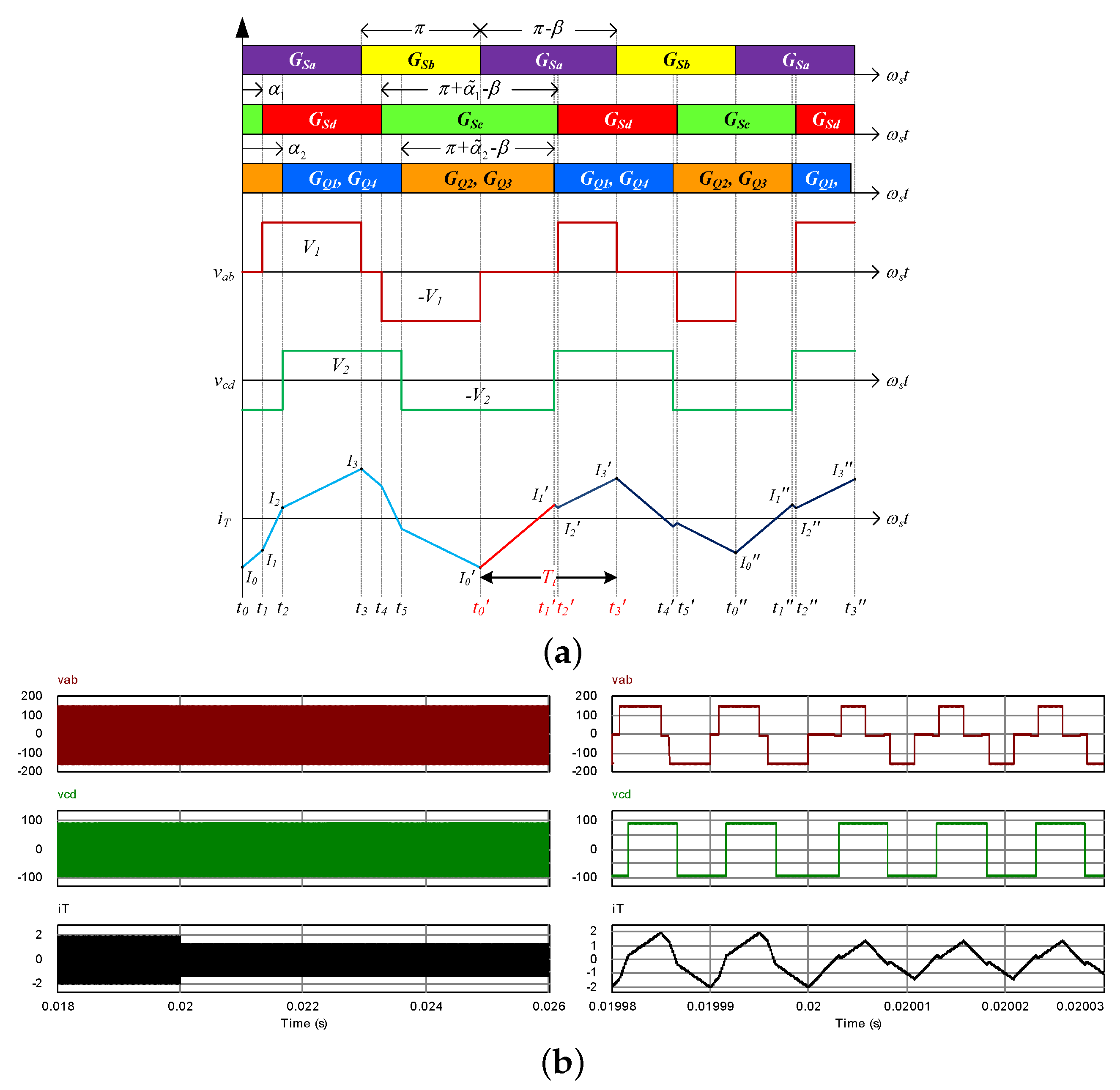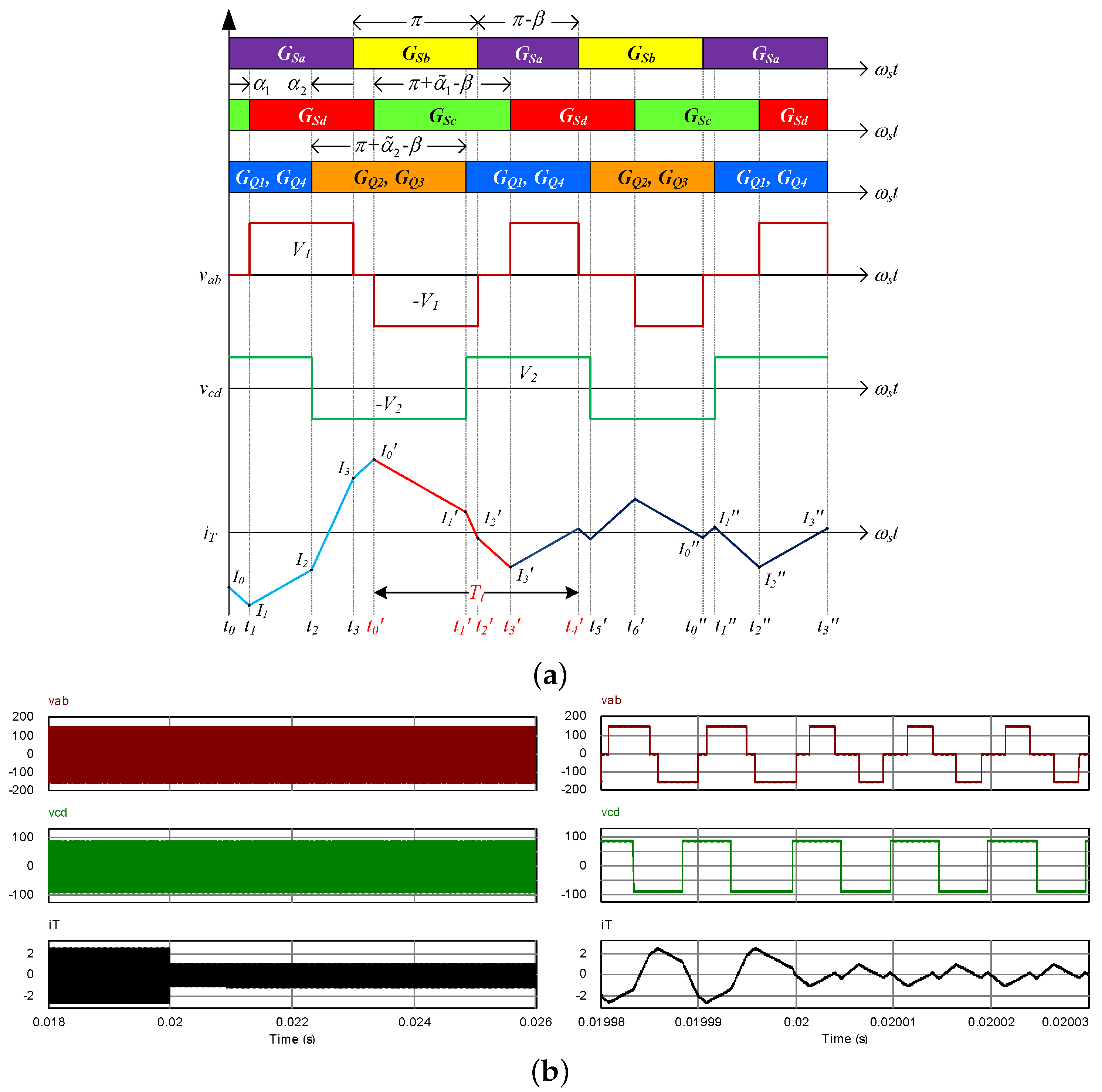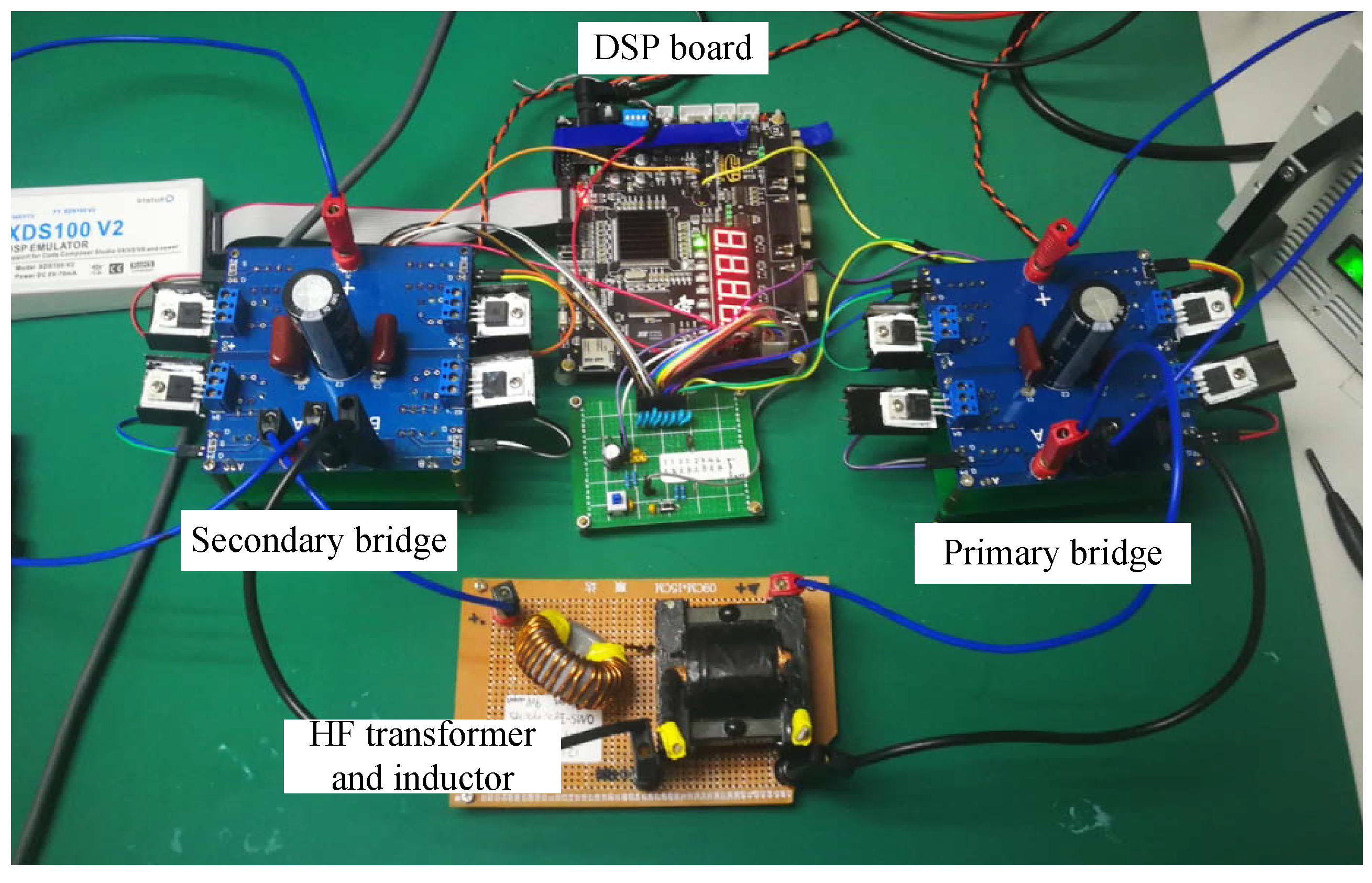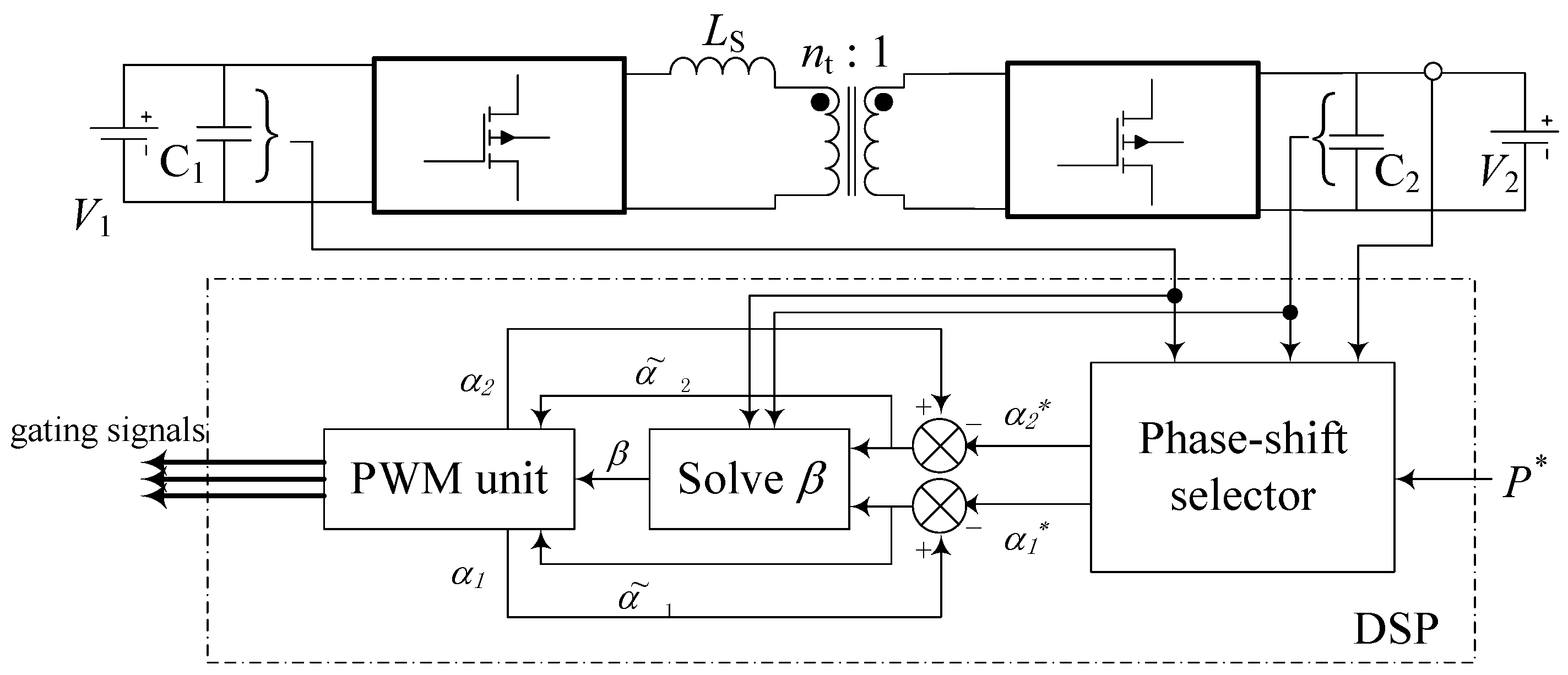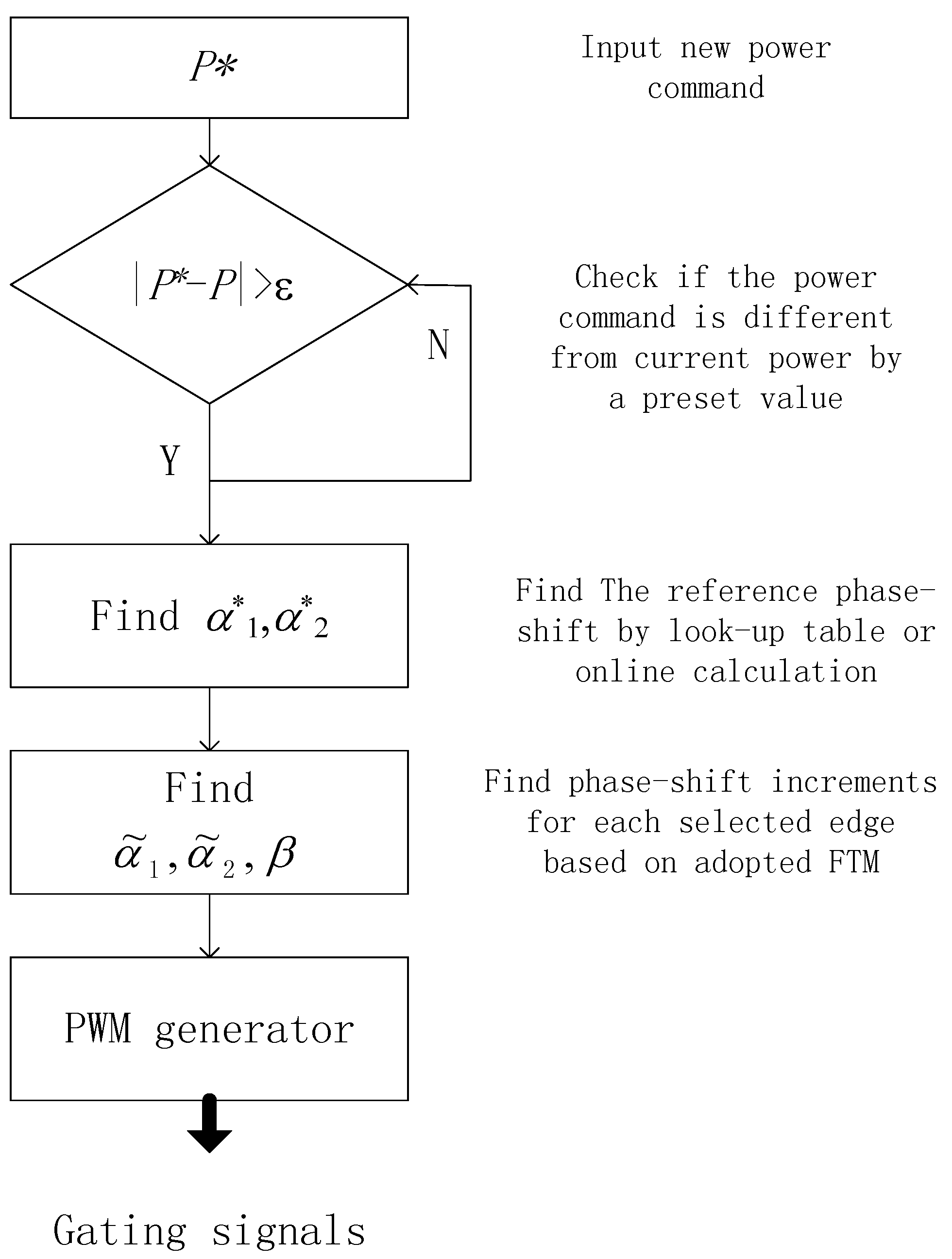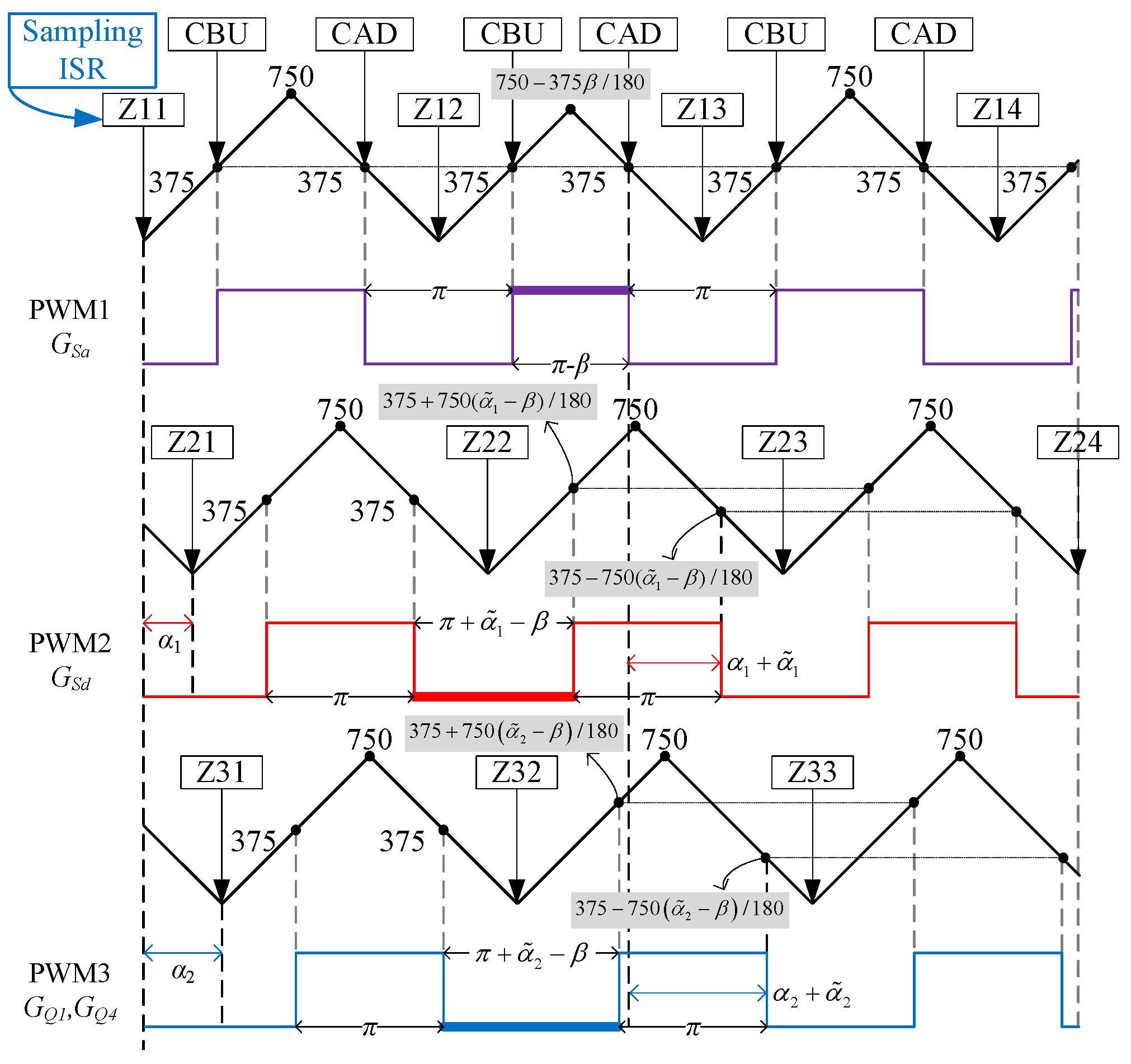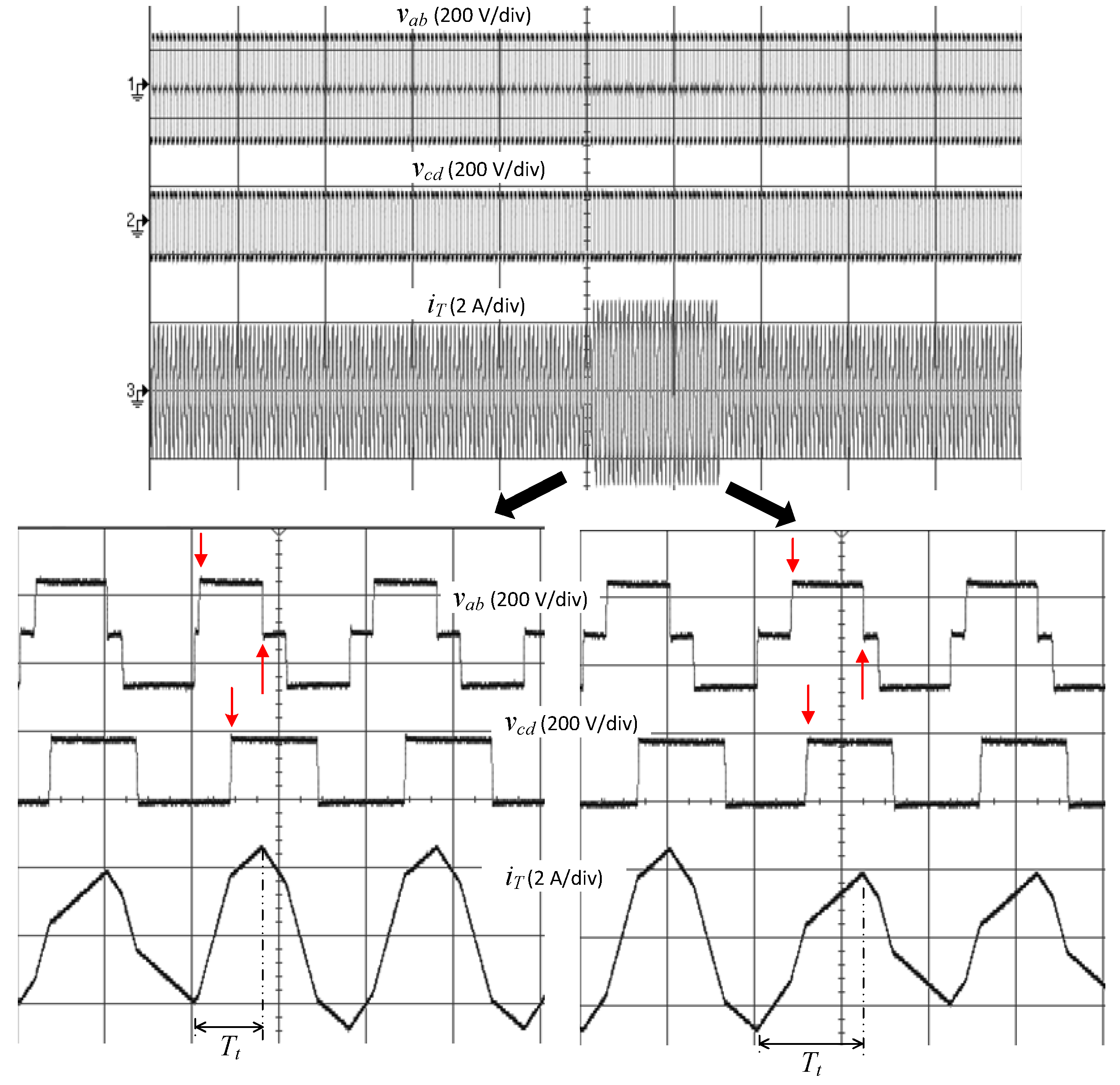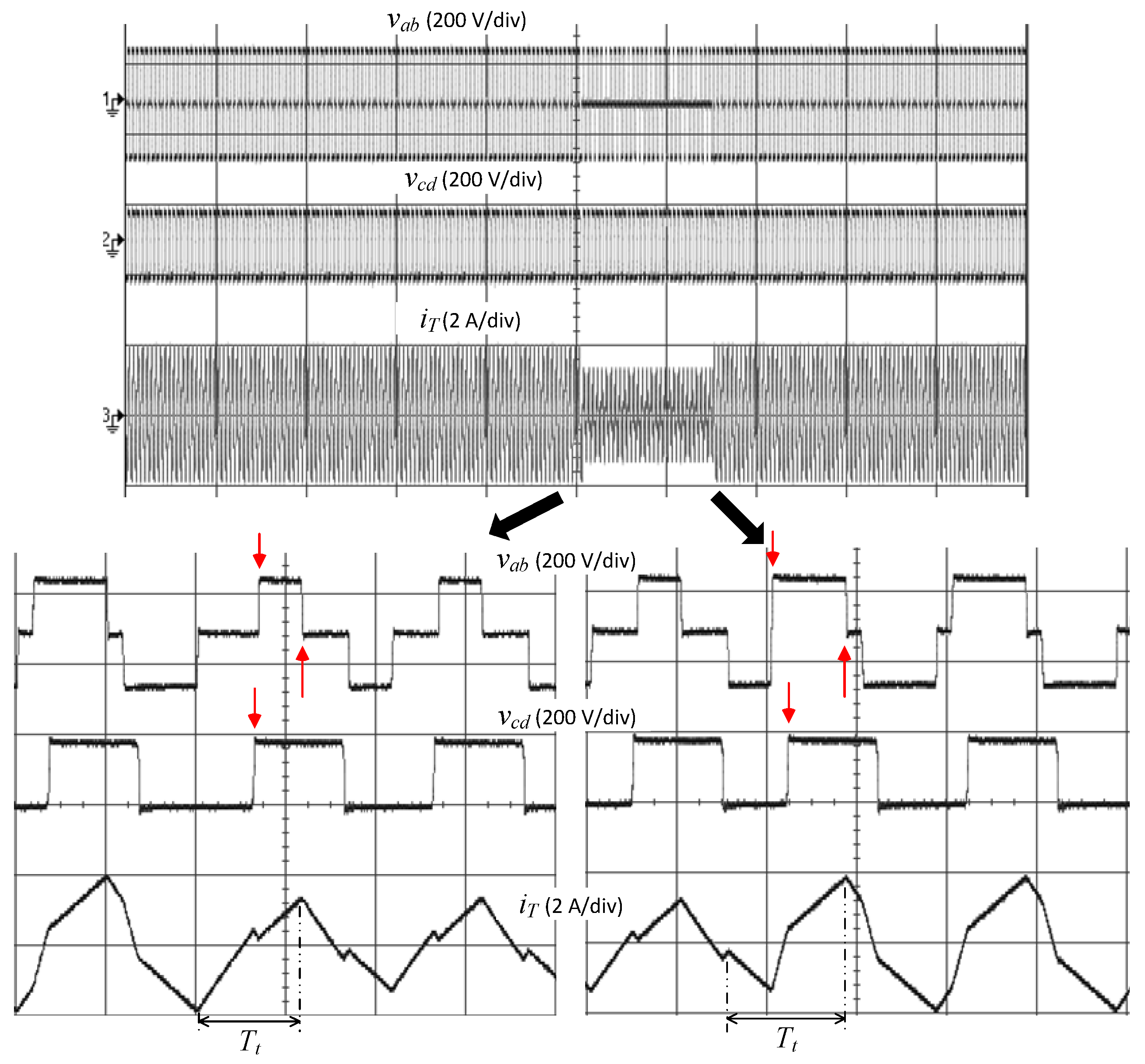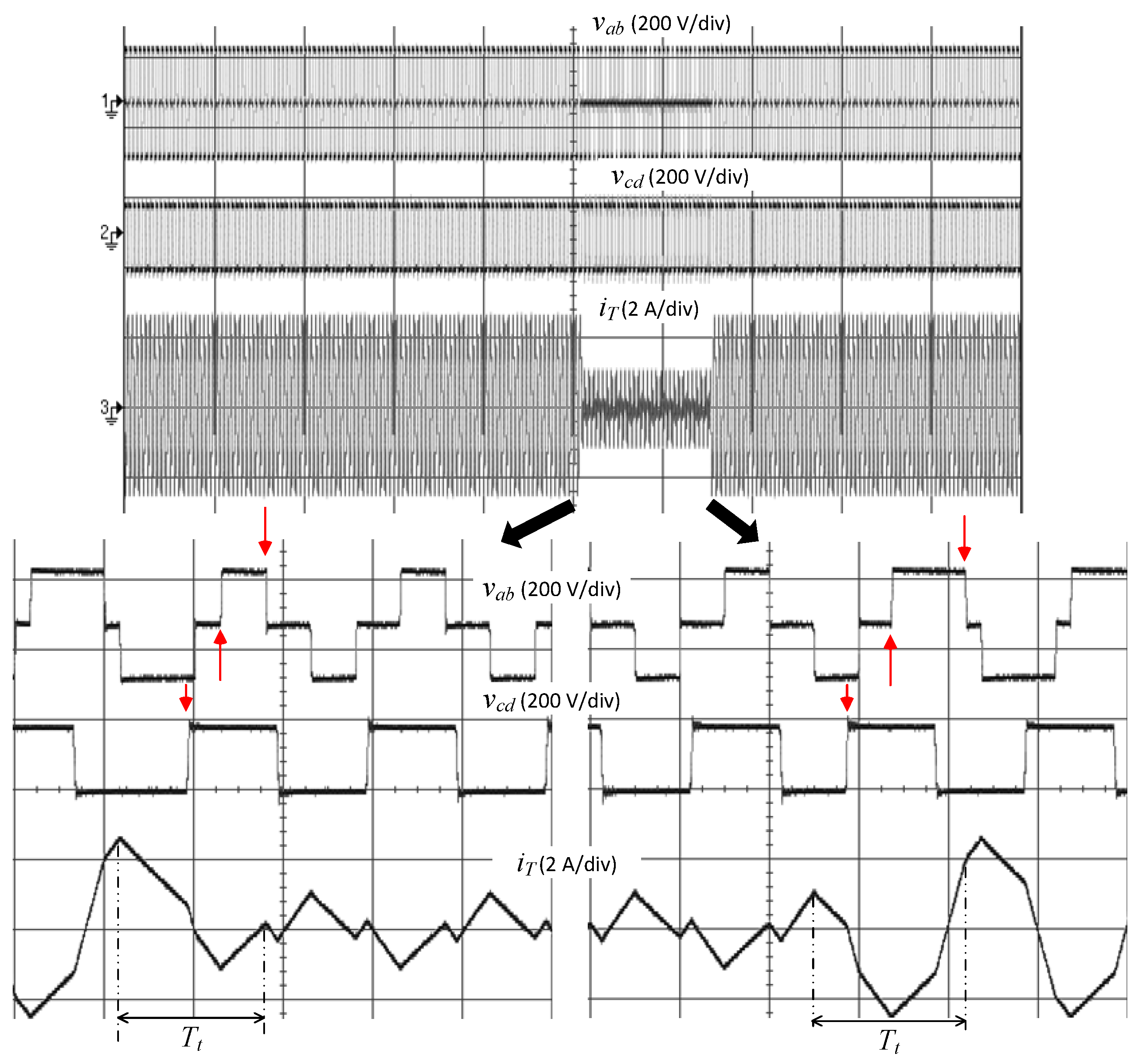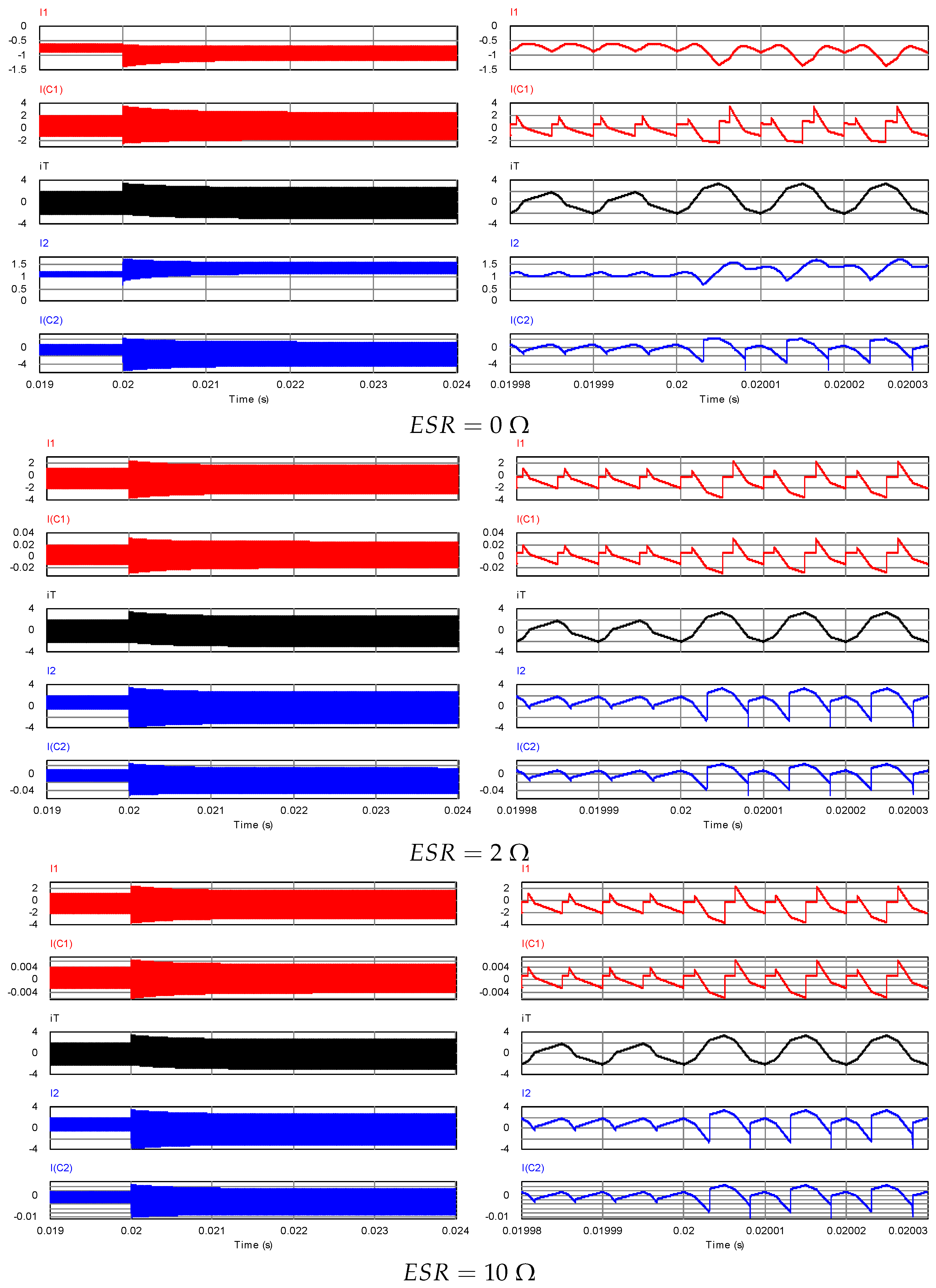1. Introduction
Isolated bidirectional DC/DC converters (IBDCs) are the key components in energy storage systems in applications of renewable generation and electrical transportation [
1,
2,
3,
4,
5,
6,
7,
8,
9,
10,
11,
12,
13,
14,
15,
16,
17,
18]. Generally, it is used as an interface between two voltage sources for bidirectional power exchange. As a typical voltage-fed IBDC, the dual-active-bridge (DAB) DC/DC converter has been discussed continuously and extensively in the literature for more than two decades. Featured with high power density, high efficiency and a wide range of zero-voltage switching (ZVS) operations, initially, it was proposed to be controlled by an outer phase-shift, named phase-shifted modulation (PSM) or single phase-shift (SPS) [
9,
10,
11]. However, there are two apparent drawbacks associated with SPS control: limited ZVS operation range with non-unity converter gain and high circulating current at partial load. Different modulation techniques are then proposed to either extend the ZVS range or alleviate the circulating current, which include extended phase-shift (EPS) [
6,
12,
13,
14,
15,
16], dual-phase-shift (DPS) [
17,
18,
19,
20,
21] and triple-phase-shift (TPS) [
22,
23,
24]. Generally, those advanced control strategies introduce one or two controllable inner phase-shifts, so that the power becomes a function of up to three variables. Additionally, there are some research works focusing on the modeling and closed-loop control of a DAB converter. Comparatively, there are only a few works reported concerning the transient performance of a DAB converter, especially the step-change of phase-shift angles [
25,
26,
27,
28,
29,
30,
31]. When a step load change is requested in a DAB converter, one or more phase-shift angles are to be adjusted accordingly to let the converter move from one steady state to another. Those adjustments are realized by manipulating the gating signals of those active switches. It can be proven easily that unplanned and arbitrary implementation of those adjustments may induce transient DC bias current in the transformer and accompanied high peak current, which may result in excess loss and safety issues potentially. Using a series DC-blocking capacitor is a simple and effective way to eliminate DC bias in the high-frequency (HF) transformer current resulting from static inconsistencies of gating signals and switch parameters. However, the stored energy in the DC-blocking capacitor due to the step change of phase-shift angles could result in current oscillation and extend the settling period. Furthermore, the extra capacitor increases the cost and the volume of the converter. The instantaneous current control in a DAB converter [
25] provides another effective solution at the cost of complicated control design and circuitry. In [
26], the required increment of the outer phase-shift was distributed unevenly to the two bridges according to an optimized ratio so that no DC bias current would arise during the transition process. Following that principle, a transient strategy is developed in [
27] that can be applied in EPS. However, no investigations of its capability to perform a transition in negative power modes and perform power direction reversion are revealed. Furthermore, when the converter gain approaches unity, the given solution with a near-zero denominator would result in an extra-large phase-shift, which will make the inductor current become discontinuous. A similar solution was given for a single-phase DAB under SPS control in [
28] by changing the gating signals of two arms in one bridge twice continuously, which could also be applied to reverse the power flow instantly. However, it may induce a peak current under some specific conditions. In [
29], the voltage-time balance during the process of changing load was maintained by temporarily introducing two more phase-shifts, though the steady-state control was still SPS. Furthermore, the transient effect on the magnetizing inductance of the HF transformer was considered in this work. The work presented in [
30] tried to use a similar principle for a three-phase DAB converter under TPS control to eliminate the transient DC bias. However, the solution was given with an assumption of a fixed outer phase-shift angle. In order to avoid the saturation problem, an excellent, but complex method called “magnetic ear” was proposed in [
31], which requires an auxiliary core and extra circuit to compensate for the DC bias. Conclusively, until now, most of the reported solutions were limited to SPS control. As mentioned early, many advanced control techniques have adopted two or more phase-shifts for power manipulation with more different operation modes. Consequently, there will be more different transition cases, and the complexity level to adjust more phase-shift angles together increases, as well. Therefore, it will be meaningful to search for a new transient modulation for those multi-phase-shift control schemes. In this work, a predictive load transient modulation for EPS control will be proposed to execute the adjustment of gating signals during the load-changing process. It will be proven to be applicable for any of the possible cases of transition between the different steady-state operation modes. The associated simple calculation and easy implementation make it an economic and effective solution.
The rest of the paper is organized as follows.
Section 2 describes the principle of EPS control and its associated distinctive operation modes. One transition case is used as an example to illustrate the problems if direct transient modulation is used. The proposed load transient modulation is presented in
Section 3 for fast and smooth transition, which are explained in detail in three different categories. In
Section 4, the transition cases using the proposed transient modulation are verified by a series of experimental tests. Finally, conclusions are drawn in
Section 5.
2. Load Transient Problem under EPS Control
The circuit schematic of a DAB converter with its steady-state equivalent circuit is shown in
Figure 1. Two active full-bridges are connected via an HF transformer and a power inductor
. The transformer magnetizing inductance is assumed to be infinite, and the transformer leakage inductance can be included as part of
. The power can be exchanged between two DC voltage sources
and
. The series resistance
is an equivalent parasitic resistance including the total winding resistance and the on-state resistances of switches.
The two phase-shifts adopted in EPS include one inner phase-shift
and one outer phase-shift
. According to [
14,
15], the inner phase-shift should be used on the high-voltage side to achieve better performance. In this work, it is assumed that
is higher than
. Therefore, the inner phase-shift
is defined as the phase delay from the turn-on moment of
to that of
, which ranges from 0–
regardless of the power direction. The outer phase-shift
is defined as the phase delay from the turn-on moment of
to those of
,
, which can be either positive or negative. Based on the relationship among
,
and average power
, there are four different steady-state operation modes: A
, A
, B
, B
. The superscript indicates the power direction, with “+” for the power flowing from
to
and “−” for the power flowing from
to
. In
Figure 2, the steady-state waveforms of the four modes are illustrated with the gating signals of all switches presented. It can be seen that those modes differ from each other in the power direction, the relationship of the two phase-shift angles and the shape of the inductor current. The range of phase-shift angles in each mode is illustrated in
Figure 3. In each steady-state time interval, a general differential equation can be written by referring to the equivalent circuit in
Figure 1:
Solving this first-order RLcircuit yields:
If the time constant
is much larger than the duration of the time interval
, Equation (
2) can be approximated as:
which is widely used for steady-state analysis of DAB converters in the literature. Therefore, the instantaneous current values at the switching moments of all switches can be found as the functions of
by solving Equation (
3) in one HF period sequentially. Those currents are normalized by the base value
and are concluded in
Table 1. The converter voltage gain is defined as:
.
When a step load change in a DAB converter happens, the two phase-shift angles are to be changed to accordingly. It is assumed that the values of will be determined by one preset control strategy for the purpose of some performance optimization. In the current work, the main focus is put on the effect of the implementation of those modifications of phase-shift angles on the transient performance in a DAB converter.
Since a DAB converter with EPS control has four different operation modes, the number of total transition cases is up to
. In the later part, the notation {
x,
y} will be used to denote a transition from mode
x to mode
y, where
x or
y can be any of the four different modes. From the definition of
, it can be seen that those two phase-shifts are relative positions referring to the turn-on moments of
. Therefore, if
are supposed to be adjusted, the simple and direct way is to change the related delay of the turn-on moments of
and
,
referring to that of
. One example of such a direct transient modulation (DTM) applied to the transition {A
, A
} is shown in
Figure 4. It is assumed that the gating signals of switch arm (
,
) will not be changed. Consequently, the turn-on moment of
and the turn-on moment of
,
are delayed from the previous position by
and
, respectively. Thus, the adjustment of the two phase-shift angles is finished in
. The values of the new steady-state tank current can be obtained as:
Compared with the content of
Table 1, those values are different from the theoretical values expected at
in Mode A
. The valley current
is the same as before, while the peak current
is higher than the theoretical new peak current. While bringing up some extra conduction loss, this unexpected peak current or overshoot current may be out of the safe operation area (SOA) of the switches. Furthermore, the average current after the transition process is not zero:
The theoretical reason can be viewed from the waveform of
shown in
Figure 4a, as well. It is seen that the voltage-time product of the inductor in the initial steady state is
. Due to the implementation of the adjustment of gating signals, the voltage-time product then becomes
. Although the voltage-time balance is still kept after
, there is a net increment from
to
:
which indicates the consequence of Equation (
8). The simulation of such a transition using DTM for
is presented in
Figure 4b with the waveforms of
,
and
. In the left part with a large time scale, the overshoot peak current after the transient modulation can be easily identified from the envelope of the inductor current. The vertical asymmetry of the current waveform reveals the existence of a DC bias current. The details of the transition process are demonstrated in the right part, which matches the theoretical prediction given in
Figure 4a. In an actual DAB converter, the overshoot current and non-zero DC bias current will decay gradually due to the non-zero parasitic resistance
. In
Figure 5, simulation plots of transient responses under DTM with three different
are presented. It can be seen that the larger
is, the faster the DC bias current will decay. However, a larger
is not preferable since it results in more copper loss. Theoretically, the negative effects due to direct changes of two phase-shift angles exist in other cases of transition, as well. Therefore, the adjustments to the two phase-shift angles should be executed in a proper manner so that the total transient duration is significantly reduced and has no dependance on
. Meanwhile, the temporal overshoot current and DC bias current are expected to be zero.
4. Experimental Verification
To verify the proposed FTM practically, a prototype of a DAB converter is built and tested in the lab. The voltage levels of two voltage sources are:
= 150V;
= 90V. The HF transformer is built using a ETD-49 ferrite core. The turns ratio is
:1 = 10:10. Therefore, the converter voltage gain is
. The measured magnetizing inductance and total leakage inductance are 390
H and 0.8
H, respectively. Including the leakage inductance of the transformer, the effective inductance of the power inductor is
H. The switching frequency is
kHz. The model of MOSFET switches on the high-voltage side is STP40NF20 with
, and the model of MOSFET switches on the low-voltage side is IPP200N15N3 with
. The key specifications of the experiment are concluded in
Table 2, and a photo of the actual circuit setup is presented in
Figure 10.
The layout for the implementation of the proposed FTM using a TI-F2835 DSP (Digital-Signal-Processor) development board is give in
Figure 11. The flowchart of the program executed in the DSP is illustrated in
Figure 12. The DSP program checks its input regularly for a new power command. Once a new power command of
is confirmed, the power difference
is evaluated. The actual power level
P is calculated by sampling the DC voltage and current on one side. If
is larger than a threshold value, the phase-shift selector will start to search for new
of the target load level. As mentioned before, the strategy used in the phase-shift selector can be customized for the purpose of any performance requirement. In the experimental setup, a look-up table is just used as an example, of which the values of phase-shifts and their increments are selected for the purpose of the clear demonstration of the variation in the transformer current during the transition. Once the reference phase-shift angles are known, the increments of phase-shift angles
and
can be calculated and sent to the PWM unit. The detail of the PWM unit can be viewed from
Figure 13. Three counters are set in up-down mode with a period of 750 cycles, which is equivalent to 5
s. The initial compared values are set at 375 to generate 50% duty cycle gating signals. Once the transient state is triggered in the interrupt service routine (ISR), the pulse-width of each gating signal would be modified according to
and
. The modification can be done by changing the period of the counter or changing the compared values on the rising or falling side.
As shown in
Figure 14, the first test case is the transition of {A
, A
} using DTM as a comparison benchmark. The original phase-shifts are
at 100 W and the increments are
. As seen in the upper part of
Figure 14 (time scale 200
s/div), the peak value of
jumps from 1.95 A–3.52 A abruptly, which would results in a temporal DC bias current at 0.78 A. The envelope of
then moves down gradually until it enters into the new steady state with an amplitude at 2.73 A at 130 W. The total transient process lasts for about 100
s. The amplified detail of the process can be observed in the lower part of
Figure 14 with a time scale of 10
s/div. By referring to the rising edge of
(from
–0), the rising edge of
(from 0–
) and the rising edge of
are delayed from their original positions by
,
, respectively. The tendency of
to decay slowly after the modification of gating signals can be identified clearly. As seen in
Figure 15, the similar long transition process with DC bias current also happens in the transition of {A
, B
} and {B
, B
} if DTM is still adopted.
In
Figure 16,
Figure 17,
Figure 18 and
Figure 19, the experimental plots of the transition cases using the proposed FTM are presented. In each test case, the converter undergoes two consecutive opposite transitions with a time interval of 300
s in between. In each figure, the upper part gives the view of the two consecutive transitions in a large time scale of 200
s/div. The amplified view of each transition will be demonstrated in the lower part in a small time scale of 5
s/div.
In
Figure 16, the conditions of the first transition are the same as those in
Figure 14, while the following second transition is the reverse process of the first one. According to Equation (
12),
and
,
. When the power is increased from 100 W–130 W, the rising edge (from 0–
) and the following falling edge (from
–0) of
are shifted earlier by
and
respectively, which realizes the adjustment of
to
. Meanwhile, the rising edge of
is delayed by
, which realizes the adjustment of
to
. It can be seen from the current envelope that
is always symmetric about the x-axis, though its amplitude undergoes two changes. Thus, the two transitions are completed almost instantly without introducing overshoot current and non-zero DC bias.
A shown in
Figure 17, another example of the Type I case is the transition of {B
, B
}, in which the power level is increased from 25 W–60 W and then changed back. The initial phase-shifts are
, and the increments are
. The conditions for the power up transition are same as those in
Figure 15 using DTM. With the help of FTM, the adjustments to the two edges of
are
and
, respectively, and the adjustment to the rising edge of
is
. After 300
s, the process is reversed, and the converter is back to the initial steady state instantly. From both the envelope and the detail of current
during the transient process, it can be seen that the adopted FTM effectively completes the transition as predicted in a fast and smooth way.
The measured plots shown in
Figure 18 are for the transition of {A
, B
} and {B
, A
}. The conditions of {A
, B
} are the same as those in
Figure 15 using DTM. The phase-shifts at 100 W (Mode A
) are
, and the phase-shifts at 55 W (Mode B
) are
. In the transition of {A
, B
}, the required adjustments are calculated as
and
,
, while in the reverse process of {B
, A
}, the polarities of those values should be reversed. It can be seen that the peak current has two step changes from 1.95 A–1.36 A and then back to 1.95 A without any delay.
Experimental plots of transitions between two modes at negative power, {A
, B
} and {B
, A
}, are presented in
Figure 19. The phase-shifts at high power
W (Mode A
) are
, and the phase-shifts at low power
W (Mode B
) are
. In the transition of {A
, B
}, the required adjustments are
and
,
, while the polarities of those values should be reversed in the transition of {B
, A
}. Both transitions start from the falling edge of
(from 0–
). The difference is that
lasts for four time interval intervals in {A
, B
} and five time intervals in {B
, A
}. The inductor current amplitude jumps from 2.52 A–1.19 A and jumps back after 30 HF periods. No noticeable overshoot current is observed from the current envelope at the transition moments.
According to the experimental plots, FTM shows satisfactory performance, which proves it to be a simple and easy-to-use solution. It is true that ZVS is not maintained for some switches for some cases from the experimental plot. However, this is the inherent feature of the steady-state mode itself. The application of FTM aims to achieve a fast load transition process without DC offset and does not bring extra switching loss. It is the duty of the phase-shit selector to choose a soft-switching control route.
Theoretically, the existence of ESR (equivalent series resistance) of filter capacitors may affect the dynamic response of the capacitor voltage and consequentially affect the inductor current. In real applications, small ESR can be realized by parallel connection of electrolytic capacitors with large ESR and film capacitors with low ESR. To check the effect of filter capacitor ESR, three cases with different ESR values of
and
are evaluated for both DTM and FTM in simulation. It is assumed that the ESRs of
and
are the same, which are assumed to be
, respectively. The plots of the transformer current
,
(current of
) and
(current of
),
(current of
) and
(current of
) are displayed together. Besides, the internal resistance for both
and
are set at 0.2
in the simulation. According to
Figure 20 and
Figure 21, the effect of ESR on the inductor current
is negligible for both steady state or transient response with either DTM or FTM. Due to the the non-zero ESR, the current ripples becomes higher in the two voltage sources. On the other side, the voltage source currents
and
show better dynamic response if the proposed FTM is applied regardless of the value of ESR of
,
, which is attributed to the improved transient response of
.

